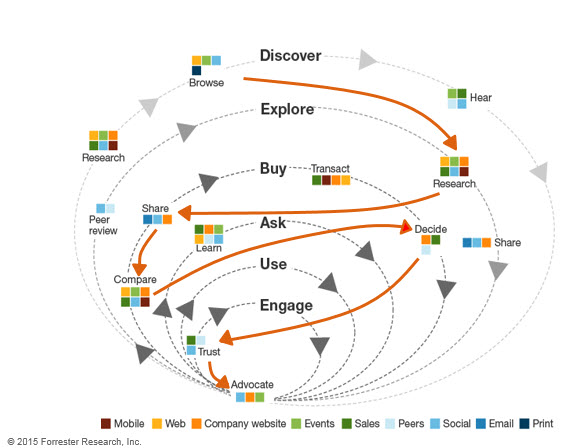Myth Busting 101: Insights IntoThe B2B Buyer Journey
There is turbulence in the B2B marketing zeitgeist. Why? The most quoted factoids of the modern marketing age have been discredited. Are buyers really not 57% of the way through their journey before they speak with a vendor sales rep? Are they really not sourcing 67% of their buying research online? Was it ever true? If not, how can we believe the new insight that sales rep involvement now starts at the beginning of the journey two-thirds of the time?
B2B marketers, keep calm and carry on. There’s been no fundamental disruption in your world.
It’s still true that today’s buyers control their journey through the buying cycle much more than today’s vendors control the selling cycle. In a recent survey, 74% of business buyers told Forrester they conduct more than half of their research online before making an offline purchase. This buyer dynamic changes the role of B2B marketing in a fundamental way. But that’s where the prevailing knowledge about ‘today’s buyer’ will fail you.
You gotta know YOUR buyer.
All of these arresting statistics about buyers represent buyer behavior on average. Averages are great because they show us directional change in the aggregate. But savvy marketing practitioners know that it’s irresponsible to build your customer engagement strategy on aggregate trends. The behavior and proclivities of your buyers might be very different from those averages. Forrester’s detailed research into buyer behavior (Forrester Business Technographics Global Priorities & Journey Survey, 2014) consistently proves that hypothesis. Consider these examples:
- When we look at the buying process for “Mobile Devices, Apps, Platforms, & Management Software” our research tells us that for all of the people involved in the Discover stage of the buyer’s journey, the Sales rep in person is the fifth most influential channel –behind Peers, Tech Analysts, IT Forums and Tech Pubs. And, if we look at just one stakeholder, the CIO, for that same product category, at the same stage, we find that Sale rep in person doesn’t make the top ten.
- However, for “Storage” buying decisions, Sale rep in person ranks at #2 (with 20% choosing it as a primary resource), right after Vendor Websites (at 22%)
- And, when we look at the Explore stage we find that the Sales rep in person is the most influential channel for some categories, such as “Business Intelligence and Analytics”. But, for buyers of other categories, such as “Security Software” Sales rep in person is #6 on the list after Tech Info Websites, Tech Analysts, Vendor Websites, Peers, IT Forums.
Build your marketing strategy on facts, not factoids.
Headline grabbing B2B marketing factoids might be useful for vendors, but don’t make the mistake of running your marketing program on the averages. You need to engineer a cross-channel, engagement strategy to successfully engage with your buyers, who proactively seek the information they need — through digital and social channels, from peers, on YouTube, at events, and, yes, through your sales reps — to advance their decision process. And there’s no one right way to do this. Buyer journey mapping is a technique B2B marketers can use to understand your buyers’ path to purchase. (For more info, see my prior blog post on B2B buyer journey mapping).
And remember, the customer will choose the channel.
Some buyers prefer to engage with a sales rep who can help them create and evangelize a vision; other buyers want to educate themselves through professional contacts and peer-created content; and yet others are comfortable doing research on vendor websites. For certain common scenarios now, self-service eCommerce websites can serve B2B buyers more effectively than salespeople can. When engineering a channel strategy that needs the proper mix of digital and human touches, keep in mind that both message development and delivery are impacted by:
- Solution & market maturity. B2B buyers thoroughly research their purchase decisions. Leveraging the large body of codified knowledge available for mature solutions, buyers conduct significant research before they engage with the vendor’s sales team. The opposite is true for products and services in new or emerging segments. Despite the rise of the self-educating buyer, business decision-makers still want to talk to salespeople for clarification when considering innovative or disruptive solutions. Sometimes, you need a person to connect the dots so that the customer gets it.
- Buying process complexity. You don’t create value in the lab, the design studio, or the manufacturing plant; you create value when buyers use, implement, or consume your product or service. Today’s buyer knows that. Solutions that require significant process or cultural change result in longer buying cycles for two reasons: 1) They involve more stakeholders and 2) today’s savvy buyers create the value realization plan before they commit to an investment. Of course, this more complex buying process creates longer buying cycles and increases the need for sales and marketing to develop a collaborative customer engagement strategy.
So, the key to engineering the perfect mix of sales and marketing engagement?
Well, there is great deal of deep research and thoughtful analysis addressing that question in a report, “Threats to The Traditional Sales Force Will Change the Focus for B2B Marketers”, which was written by my colleague Andy Hoar, with B2B marketing insight added by Forrester research director, Peter O’Neill.
But, the short answer is ….
It’s the customer.
